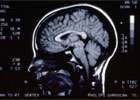Computer programs may be able to identify individuals most at risk of anxiety, mood disorders

(Medical Xpress) -- Computer programs can be taught to differentiate between the brain scans of healthy adolescents and those most at risk of developing psychiatric disorders, such as anxiety and depression, according to research published yesterday in the open access journal PLoS ONE. The research suggests that it may be possible to design programs that can accurately predict which at-risk adolescents will subsequently develop these disorders.
There are no known biomarkers - biological measures - that can accurately predict future psychiatric disorders in individual adolescents. Even genetic risk cannot accurately predict individual risk for future psychiatric illness: for example, a family history of bipolar disorder confers a 10 per cent risk of future bipolar disorder, as well as a 10 to 25 per cent risk of disorders such as attention deficit hyperactivity disorder, major depression and anxiety disorders, but it is impossible to accurately determine whether an individual will develop these disorders.
The early identification of individuals at high risk of future psychiatric illness is critical. Most psychiatric disorders typically have an onset in adolescence or early adulthood, and early detection and treatment could potentially delay, or even prevent, the onset of these illnesses in high-risk adolescents.
Now, a team of researchers led by Dr Janaina Mourao-Miranda, a Wellcome Trust Research Career Development Fellow at UCL (University College London), has shown that computer programs can distinguish between brain scans of healthy but genetically at-risk adolescents and healthy low-risk controls.
Sixteen healthy adolescents who each had a parent with bipolar disorder took part in the study, along with 16 healthy adolescents whose parents had no history of psychiatric illness. The adolescents performed an emotional face gender-labelling task in a functional magnetic resonance imaging (fMRI) scanner, which measures activity in the brain.
In the first experiment, the faces presented had happy or neutral expressions; in the second experiment, the faces had fearful or neutral expressions. The researchers then used a computer program capable of machine learning to predict the probability that an individual belonged to the low-risk or the at-risk group.
They found that the program was accurate in three out of four cases. The predictive probabilities were significantly higher for at-risk adolescents who subsequently developed a psychiatric disorder, such as anxiety and depression, than for those who remained healthy at follow-up. This suggests that it may be possible, in time, to develop a computer program able to identify those individuals at greatest risk of developing psychiatric disorders.
Interestingly, the researchers found that the best discrimination between at-risk and low-risk adolescents occurred when neutral faces were presented in the happy face experiment. This supports previous studies that suggest that individuals diagnosed with anxiety or mood disorders are more likely to perceive neutral faces as ambiguous or potentially threatening.
"Combining machine learning and neuroimaging, we have a technique which shows enormous potential to help us identify which adolescents are at true risk of developing anxiety and mood disorders, especially where there is limited clinical or genetic information," says Dr Mourao-Miranda.
Coauthor Professor Mary Phillips, from the Clinical and Translational Affective Neuroscience Program at University of Pittsburgh, adds: "Anxiety and mood disorders can have a devastating effect on the individuals concerned and on their families and friends. If we are able to identify those individuals at greatest risk early on, we can offer early and appropriate interventions to delay, or even prevent, onset of these terrible conditions."
The study was funded by the National Institute of Mental Health, the Wellcome Trust and Coordenação de Aperfeiçoamento de Pessoal de Nível Superior (Brazil).
More information: Mourao-Miranda J et al. Pattern recognition and functional neuroimaging help to discriminate healthy adolescents at risk for mood disorders from low risk adolescents. PLoS One 2012 (epub ahead of print).














